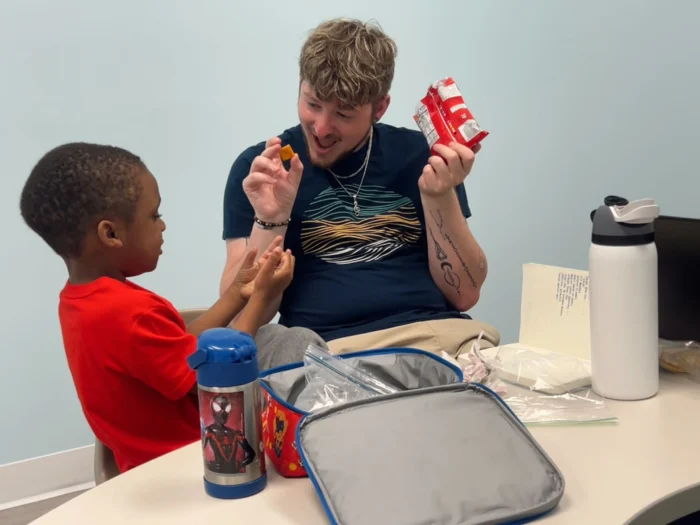
For many parents of children on the autism spectrum, starting ABA therapy is a major step toward helping their child develop essential skills. But with time, an important question arises: When is the right time to stop ABA therapy?
There’s no one-size-fits-all answer. Some children may be ready to transition sooner, while others benefit from continued support.
In this guide, we’ll explore the signs that tell you it may be time to reduce or stop ABA therapy and how to navigate the process effectively.
How Long Does ABA Therapy Last?
Every child’s ABA therapy journey is unique, and while we’ve seen therapy typically last three to five years, the duration depends on each child’s individual growth.
On average, children start with comprehensive therapy for two to three years before transitioning to more focused support. And early intervention, ideally between ages two and six, can lay a strong foundation and influence the length of therapy.
However, as a definitive answer ABA therapy has no age limit—it can be beneficial at any stage of life, including adult.
ABA Therapy Success & Long-Term Impact
Research shows that ABA therapy significantly helps children grow in a loving and supportive environment, with benefits that last long after sessions end. There is also strong evidence that starting ABA early is beneficial, leading to better communication, social interactions, and independence for children with autism.
You’re likely to hear positive as well as negative comments about the ABA method, but many parents report long-term benefits that continue well beyond therapy sessions.
How Long Are ABA Therapy Sessions for Kids?
In terms of weekly commitment, most children dedicate 10 to 30 hours each week to therapy, though those in more intensive programs may attend 30 to 40 ABA therapy hours per week.
Sessions last anywhere from two to seven hours, depending on the needs and abilities of the child. Depending on how the child feels, the number of hours may decrease or increase.
At some point, you may wonder: is 6 hours of ABA therapy enough? Admittedly, it could work well for someone, but there is no universal answer because no child is the same. That’s why you always need the help of a professional when making these decisions.
Signs It’s Time to Transition Away from ABA
While ABA therapy has great advantages for children on the autism spectrum, the path through ABA therapy isn’t meant to stretch out forever. Recognizing when it’s time to dial down or fully step away from ABA therapy requires closely monitoring your child’s growth and progress both by parents and professionals.
Here are some ABA discharge criteria examples that mean it might be time to consider a change in therapy plan:
- Your child has met your therapy objectives, such as improved communication and social skills
- Issues that once seemed insurmountable, such as tantrums or aggression, now occur less frequently or are more manageable
- Your child has developed strong daily living skills and independence
- You feel that therapy has plateaued, and you no longer see positive effects
- Other therapies may now be more beneficial as your child enters new stages of development
Regular check-ins with your child’s Board Certified Behavior Analyst (BCBA) will help ensure therapy decisions are well-informed and in the best interest of your child’s well-being.
Should You Stop ABA Therapy Gradually or All at Once?
A gradual reduction in therapy hours is often the best approach to maintain what they have accomplished and prevent regression. This allows your child to adapt at their own pace while reinforcing learned skills.
Some families transition to a consultation model, where ABA therapy is reduced but remains available as needed. This ensures ongoing support without full discontinuation.
However, if ABA therapy is causing distress or resistance in your child, a quicker transition may be necessary. Always consult with a professional before making a decision.
Life After ABA Therapy
Finishing ABA therapy marks a new chapter in supporting your child’s independence. Integrating what they’ve learned into daily life helps reinforce their growth and development.
In the first few months, keep an eye on how they’re adjusting—some challenges may come up, and it’s okay to revisit therapy if needed. Additional support like speech, physical, or occupational therapy can also build on their growth.
To keep your child engaged, explore ABA activities at home that encourage social interaction, like art, sports, or playdates. And remember, you’re not alone—lean on your support network and community as you navigate this transition.
When Should ABA Therapy Continue?
Knowing when to continue ABA therapy is just as important as knowing when to pause. If your child is still developing key skills like self-care, social interaction, or adapting to changes, ongoing support may be beneficial.
Challenges with daily routines or difficulty applying learned skills at home or school can also indicate a need for more practice.
Since therapy isn’t one-size-fits-all, regular check-ins with your child’s BCBA can help guide the best path forward for their continued growth.
Wrapping up
Deciding when to reduce or stop ABA therapy is a significant milestone. At Abacus Therapies, we are committed to supporting your child’s journey, whether that means transitioning away from ABA or adjusting their therapy plan.
If you have questions about your child’s next steps, our team is here to help. Reach out today for expert guidance and personalized support.
FAQs
How long should a child be in ABA therapy?
The duration varies depending on the child’s needs, as well as the environment and collaboration between parents, other family members, teachers, and therapists. Some children benefit from a few months of therapy, while others may continue for years.
What happens if you stop ABA therapy?
Without reinforcement, some skills may plateau or regress. That is why it’s important to continue practicing the strategies at home and seek additional help when needed.
When do you discharge from ABA?
A child is discharged from ABA therapy when they’ve met the family’s objectives, consistently apply skills in different settings, or no longer require therapy based on regular assessments.
When is ABA therapy not effective?
ABA therapy may not be effective if:
- Progress is limited despite continued efforts
- The therapy plan doesn’t align with the child’s unique needs
- Collaboration between family and therapist is lacking
- The child experiences significant distress or discomfort in sessions



